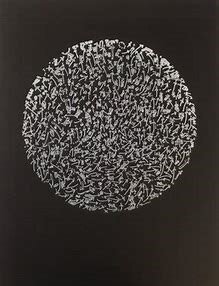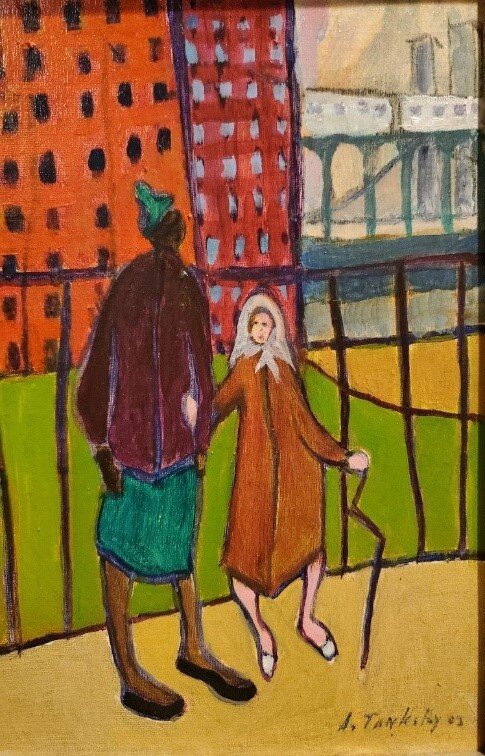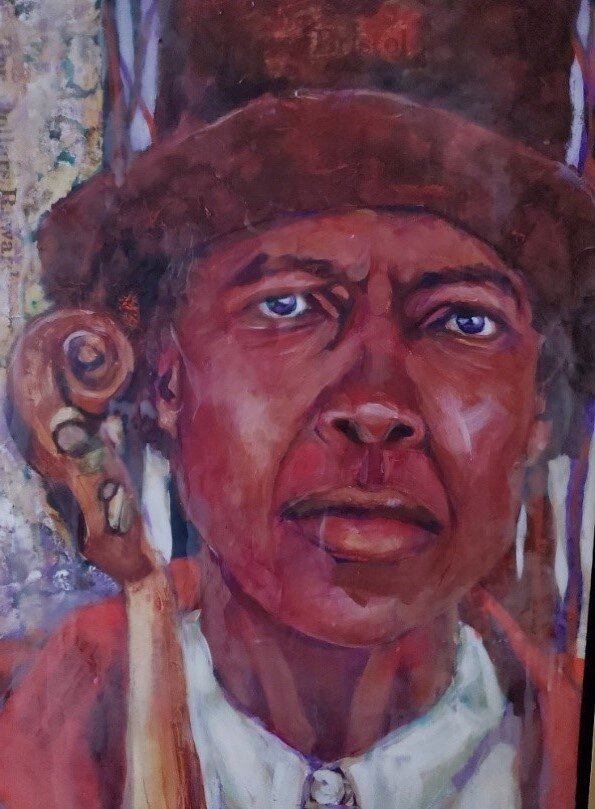Terron Cooper Sorrells’s work occupies a charged space at the intersection of art history, race, and economics. His canvases are neither passive reflections nor abstract meditations; they are direct interventions in the ways Blackness has been historically imaged, consumed, and circulated. This painting demonstrates his command of Western visual traditions—appropriating their forms while simultaneously weaponizing them to narrate the endurance of the Black body exploited as commodity.
Read More"The Cycle of Life", shows The Brilliance of Nedia Were
Nedia Were’s painting is a profound meditation on the cycle of birth, life, and death, conveyed through fragmented faces and layered symbolism. Rooted in African artistic traditions, it evokes the spiritual depth of masks and figures, connecting identity, ancestry, and transformation. The work engages with the African influences that shaped global movements like Primitivism and Cubism, reclaiming the fragmented aesthetic associated with Picasso and grounding it in African heritage.
The "Mother and Child" motif reflects the African Earth Mother, symbolizing fertility and continuity, and aligns with African cosmologies like the Yoruba and Akan, where life and death are intertwined transitions. Symbols such as the skull and lush foliage emphasize the dualities of existence—creation and destruction, presence and absence.
Drawing from the existential depth of African modernists like Ben Enwonwu, Were’s vibrant palette and symbolic forms bridge traditional African philosophies with global art conversations, offering a deeply resonant portrayal of humanity’s shared journey.
Read MoreAdrian Migadde's Spirituality: "Wake Up and Live"
Are you living true to yourself? You get rewarded by being you. Adrian Migadde
Adrian Migadde (B. 1989, Uganda) lives and explores deep “Spirituality,” and it sings loudly in his artwork. With simplicity, depth, and power his paintings’ voice is consistent with Bob Marley’s personal, humanist, spiritual side. The voice says: "Wake Up and Live.” Like Bob Marley, Adrian believes “self-realization and freedom are deeply interconnected; self-realization is discovering and embracing one’s true identity, achieving spiritual awakening, and breaking free from mental chains; freedom encompasses physical (and mental) liberation from oppression, spiritual freedom aligned with divine will, and the ability to express oneself authentically.” ChatGPT. Adrian’s striving for spirituality simultaneously creates works deeply personal but with “open to interpretation” meanings, at times disorienting, depending on the viewer’s lens. We explore the duality in Adrian Migadde’s thinking, which manifest in his paintings. Beyond philosophy, his paintings are honest, scholarly, challenging in the use of symbols, metaphors, colors; they evoke feelings and tell his story.
Read MoreElevate Your Apartment’s Style with Texture and Patterns, Ryan Castillo
https://www.apartmentguide.com/blog/apartment-textures-and-patterns/
Incorporating texture and patterns into your apartment home’s style is a powerful way to elevate its visual appeal and create a more inviting atmosphere. Whether through layered rugs, framed textiles, or thoughtfully chosen decor, these elements can transform a space from simple to sophisticated. Whether you live in an apartment in New Haven, CT, or a house in Newark, NJ, this ApartmentGuide article will teach you how to add depth, warmth, and personality to your home through art pieces, making each room feel uniquely yours.
Read MoreEmmanuel Anaiye - Semblance Realism
Emmanuel introduces us to his concept of “Semblance Realism”: “what I want you to see are my thought's appearance on canvas or apparent form of a portrait of an individual, image hidden in a reality of textured materials and colors. The idea is to move the viewer very close to each art piece so that all you see are its colors and textured effect not a face bringing the colors and materials together to form a portrait.”
Read MorePatrick Mukabi’s painting at LifeStyle Gallery
Part II: A Sense of Place
The Art Hedger, “the accidental, intuitive collector who over decades of speaking with artists…,” catches up with Issa Sylla, who was in Kenya. He encourages Issa to check out the local art scene. While in the throes of a “Pandemic Lockdown,” Issa seizes an opportunity visit art galleries. He empathically connects with the images and artists (they speak to him, as Richard Nattoo and the German Romantics would say). The works spark meaningful and genuine connections between Issa and the Art Makers. He comes away from the experience with a deeper understanding of himself; the realization that he and the artists share much in common. He leaves with a keener sense of his place. Yes, Art sparks dialogue, connections, stories, lends perspective from which we can gather meaning and it can deliver happiness, even in a Pandemic.
Read MoreIssa’s Reprieve
Discovering a Sense of Place Through Art: A Reprieve, in III Parts
The Art Hedger, “the accidental, intuitive collector who over decades of speaking with artists…,” catches up with Issa Sylla, who was in Kenya. He encourages Issa to check out the local art scene. While in the throes of a “Pandemic Lockdown,” Issa seizes an opportunity visit art galleries. He empathically connects with the images and artists (they speak to him, as Richard Nattoo and the German Romantics would say). The works spark meaningful and genuine connections between Issa and the Art Makers. He comes away from the experience with a deeper understanding of himself; the realization that he and the artists share much in common. He leaves with a keener sense of his place. Yes, Art sparks dialogue, connections, stories, lends perspective from which we can gather meaning and it can deliver happiness, even in a Pandemic.
Read MoreDecoding and Understanding Hilroy Bulgin, "The Synthesizer"
Hilroy Bulgin, Jamaican Artist
Read MoreCONTEMPORARY AFRICAN/DIASPORA ART – INTRODUCING TWO NEW ARTISTS TO KNOW AND COLLECT
Jamaican Cubist – Hilroy Bulgin & Nigerian impressionist – Emmanuel Anaiye
Jamaican Cubist - Hilroy Bulgin
Bulgin’s art is influenced by African art, like the original cubists, taking inspiration from its motif from sculpture, paintings, masks, textiles, and personal decoration. His art is varied. Some are whimsical, others created for pure aesthetic, some entertainment, and some infused with political ideology and everyday social commentary. He has love (I would say obsession) of folklore art and “primitive” (outsider) art.
Read MoreAfrican American Art – Three Artists to Know and collect
Charles Desmarais, “Art Guy”, asked “Why is African American art having a moment?” (Datebook.sfchronicle.com, Jun 02, 2019) and Culture Type tried to explain “Why African American Art is Hot”, “Having a Moment” (Tweet July 27/2019). Works by African American artists were featured prominently in auction houses, museums. Some artists achieved record prices for their work. My bet is that 2019 was not a ‘Moment’ but a continuation of a movement.
Three Artists to Know and collect
Howardina Pindell, Constellation Ann Tanksley, Untitled Cora Marshall, Runaway Slave Series
Here are three women in the Art Hedge Collection who deserve to share the ‘moment’: Howardina Pindell, Ann Tanksley and Cora Marshall. Their art works are powerful, beautiful and unique. I get the same feelings from their works like I did when I first saw Elizabeth Catlett’s Sharecropper. Perhaps, like the 86 year old abstract painter Sam Gilliam, who is getting his due, their stars will ascend.
With the exception of Howardina Pindell, the artists works are still attainable and available. We recommend that you collect them— collecting them may be a wise art investment strategy.
Art Hedge continues to nurture artists, seize the opportunity to invest in undervalued, underrepresented great art, wherever we find it.
Purchasing art from Art Hedge
If you are interested in purchasing works from us.
We value your privacy and do not keep your personal information nor we sell your private information to third parties.
If you are not pleased with your purchase, we guarantee your full refund.
Happy New Year from us at Art Hedge. May you have a successful year.
Email: Artmuze@outlook.com Telephone: 475-988-3479





